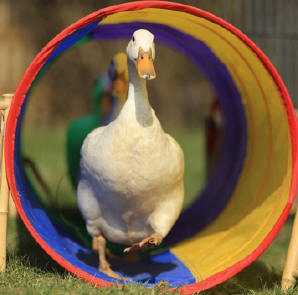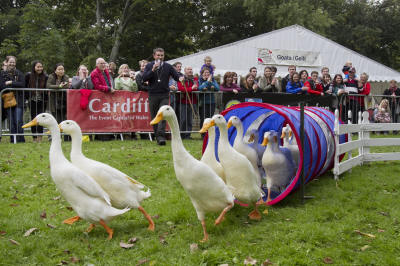Agility Duck
Dr. Kimberly Brokaw, DVM
Walkersville Vet Clinic
 (9/2016) It is always enjoyable to see people enjoying their animals in unusual ways. The majority of poultry in the US are owned by large commercial farms and are either raised for eggs or meat. Backyard flocks are increasing in popularity, so I've been
treating more and more poultry at the clinic. Most of the birds I treat are chickens kept by families for farm fresh eggs, but also enjoyed by the family as pets. While duck eggs are prized for baking, people also keep them as pets.
(9/2016) It is always enjoyable to see people enjoying their animals in unusual ways. The majority of poultry in the US are owned by large commercial farms and are either raised for eggs or meat. Backyard flocks are increasing in popularity, so I've been
treating more and more poultry at the clinic. Most of the birds I treat are chickens kept by families for farm fresh eggs, but also enjoyed by the family as pets. While duck eggs are prized for baking, people also keep them as pets.
A client, who I shall call Mrs. Palmer, has a white Peking duck named Donnie. Being a male meat breed duck, the duck's expected use would be for meat; however Donnie is a pet. Mrs. Palmer likes to teach him agility tricks. Just like the agility dogs, Donnie can run, or rather waddle, up ramps and hop through hula-hoops.
Mrs. Palmer rewards Donnie with mealworms after he successfully completes an agility task. While I thought she was the only person in the world who had taught her duck agility tricks, after a quick Google search I learned that it wasn't as unusual as I thought. The duck seems to enjoy agility as much as his owner enjoys it .
 When Donnie isn't doing agility training, he is hanging out in the chicken coop in the owner's horse pasture. The horse fencing is wood with strands of hot wire running between the boards to keep the dog from getting into the pasture and killing the birds, and to keep the horse
from killing the dog. The horse has become quite fond of the birds and Mrs. Palmer told me that he runs off any animals that tries to come in the pasture to eat her chickens and duck.
When Donnie isn't doing agility training, he is hanging out in the chicken coop in the owner's horse pasture. The horse fencing is wood with strands of hot wire running between the boards to keep the dog from getting into the pasture and killing the birds, and to keep the horse
from killing the dog. The horse has become quite fond of the birds and Mrs. Palmer told me that he runs off any animals that tries to come in the pasture to eat her chickens and duck.
One day I got a frantic call from Mrs. Palmer. Apparently a fox had gotten into the pasture and before the horse could chase him a way he had injured Donnie. She said he was alive but that his feathers were a mess and she could see blood everywhere.
When Mrs. Palmer brought Donnie to the clinic, I was relieved to see that he actually didn't have that much damage. The red blood on white feathers made it look worse then it actually was. He had a couple of punctures and one small laceration that would need a couple stitches. Truthfully he was lucky to be alive. Most birds that encounter a fox are
quickly killed.
While chickens are probably my most cooperative patients, ducks aren't quite as good. They will let you work on them to a point before they get mad and try to bite you. While their bite is painful, at least it tends not to cause significant injury like cat or dog bites. Ducks also give warning as they reach their threshold for what they are willing to
tolerate. Unlike dogs and cats that growl or hiss, ducks have the feathers on their neck stand up when they are getting mad. Once you see the feathers start to rise, the next warning is they start to shake their neck. After that they begin biting.
Donnie was a very good patient. He let me clean the wounds. I then injected a local numbing agent around the one laceration that needed stitches. While he was good for that, I could tell he didn't really enjoy it. He held perfectly still as I put in two stitches. It was after I was finished and started explaining to Mrs. Palmer how to clean the wounds
at home that Donnie was done. He started to puff his feathers and quickly started to shake his neck. I knew he wasn't going to tolerate anything else. Luckily I was finished with his treatment. I picked him up to put him back in the carrier so Mrs. Palmer could take him home. That was the final straw and Donnie bit my arm. The bite was just a little twisting pinch that was
his way of telling me that he didn't like what I had been doing.
I sent Mrs. Palmer home with antibiotics for Donnie. With food animals you have to follow antibiotic withholding times. However I knew that she had no intentions of eating Donnie and simply discussed withdraw times as matter of course. While birds do not get rabies, I advised Mrs. Palmer to talk with her own physician about any potential rabies
exposure from the fox. Mrs. Palmer reassured me that she had not been bitten by the fox, and had been many feet away when the fox released Donnie. She agreed to call her doctor to be sure she did not need rabies vaccine.
A few weeks later I received a text message from Mrs. Palmer saying that Donnie had made a full recovery and was back to jumping through hula-hoops.
Read other articles by Dr. Kim Brokaw